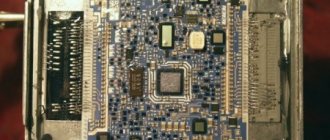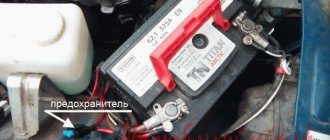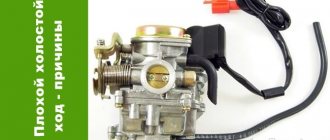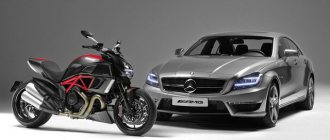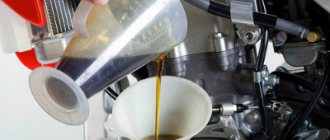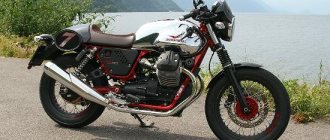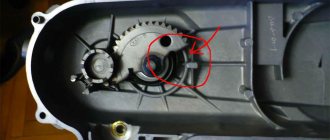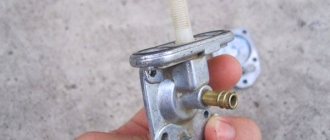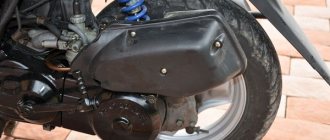way to find out why a car doesn't pull when it's hot is when it has a carburetor engine. Because as it heats up, gasoline vapors evaporate faster and the air-fuel mixture becomes leaner. An injection engine pulls worse when hot, most often if the mass air flow sensor (MAF) or coolant temperature sensor (CLT) has failed, there is an air leak or problems with the fuel pump. As for diesel engines, they have problems with hot traction due to the fuel injection pump.
The listed reasons are the main ones, but not the only ones. Below we will consider in more detail why the engine does not pick up speed when hot, as well as methods for diagnosing the malfunction and how this can be eliminated.
| engine's type | Why is it bad to go hot? | What to do |
| Gasoline injection | DMRV, DBP, DTOZh sensors | Check/clean/replace |
| Heated throttle body | Turning off the heating in the summer | |
| Gasoline pump | Checking/cleaning/replacing the fuel pump mesh | |
| Air leak in the intake manifold | Diagnosis and elimination of suction | |
| Vapor-air plug in the fuel line | Depends on engine design | |
| Ignition module | Cleaning from dirt, washing the engine | |
| BB wires and distributor | Checking insulation and, if necessary, replacing components | |
| Fuel pressure control | Inspection/repair/replacement | |
| Catalyst and lambda probes | Removing or “silencing” the catalyst, replacing the oxygen sensor | |
| Carburetor engine | Rapid evaporation of gasoline in the carburetor | Carburetor reconfiguration |
| Fuel pump overheating | Check/cool/replace | |
| Poor quality fuel | Refill with quality gasoline | |
| Diesel engine | High pressure fuel pump | Replacing the pump or replacing plunger pairs in it |
Why doesn't the engine run in the heat?
Graph of air density as temperature increases (kg/cubic meter)
To understand why the engine begins to pull worse when it heats up, it is enough to understand the conditions of fuel combustion. The fact is that at low temperatures the amount of air in one cubic meter is greater (the air density is higher), and as the temperature increases, its mass decreases. For example, at a temperature of –20°C, the mass of air in one cubic meter is about 1.4 kg, and at a temperature of +30°C, the same mass is 1.16 kg. This means that as the air temperature increases, the car begins to “suffocate” and traction decreases slightly. This is true for all gasoline engines, including fully functional ones.
But if the thrust disappears significantly on a hot engine, then it is worth looking for the reason in the fuel system or ignition, and not in the process of fuel combustion itself.
What affects the speed and acceleration of a motorcycle? On what factors does effective braking depend?
When spring-summer tourism picks up, you can often see crowds of motorcyclists gathering around every more or less interesting, fast and relatively large motorcycle. Now let’s ask ourselves the question: “How necessary is it for manufacturers to produce cars with more and more power, since speed limits still do not allow for its use?” Or is it still necessary? Previously, factories generally did not indicate in motorcycle passports what accelerations could be developed on them, but today they are already proud of them. Recommended reading: “ How to choose the best touring motorcycle? The right tips for choosing
“.{banner_adsensetext} Motorcycle power is important not only from a sporting point of view, but to a large extent it is also a safety factor. You can drive a fast vehicle that accelerates in a short time with greater safety than a slow one.
A more powerful engine has a reserve so that, if necessary, by increasing speed it can escape a tense situation, because braking is not always the most correct solution. Before getting acquainted with a motorcycle, it is useful (although it may seem boring) to briefly study the physical concepts that characterize its properties.
Good motorcycle design means that the power, gear ratios, load capacity and dimensions of a given motorcycle form an inextricable whole. A bad motorcycle is the one whose power cannot be used, whether due to an incorrect transmission design or a poorly chosen wheel size. The opposite situation may also occur, and then the engine will be overloaded.
An important characteristic of a modern motorcycle is not only
maximum speed
, but also
acceleration
. Acceleration is the increase in speed per unit time. Acceleration is measured in meters divided by a second squared (m/s2). If the acceleration is negative (this happens in the case of braking), it is commonly called deceleration. Obviously, a motorcycle that accelerates better (along with many other factors) is safer in traffic.
{banner_reczagyand} Negative acceleration, that is,
deceleration
, is an important characteristic of a motorcycle, since it characterizes the effectiveness of the brakes. Slowing down, however, is only one important part of braking. Regardless of the vehicle's load, braking systems must meet certain requirements.
So, when
braking
at different initial speeds to a complete stop, the braking distance and deceleration values should be as follows. Conclusions about deceleration can also be drawn based on the braking mark. Moreover, in police practice, the speed before a collision is determined using the brake mark and some other data. I would like the inertial force to continue to carry the motorcycle in the original straight direction when braking.
The brakes therefore need to absorb the energy of the vehicle's motion (kinetic energy).
When the speed doubles, the braking distance
quadruples. If, for example, an oil slick reduces the coefficient of adhesion by half, then the braking distance doubles. In turn, the inertial force pushes the motorcycle forward, and the braking force acting on the wheels pushes it back. This creates a torque that causes the motorcycle to swing forward. The load on the rear axle decreases and the load on the front axle increases. If the center of mass is very high and the distance between the axles is small, then the motorcycle may somersault forward.
Braking force is determined by the adhesion between the wheel and the supporting surface. You cannot brake with great force, as then the wheels begin to slide rather than roll. The force preventing lateral movement ceases, and the motorcycle becomes uncontrollable. During heavy braking (when the wheels are braked almost to the point of locking), approximately 60% of the braking force falls on the front axle and 40% on the rear axle.
The force acting on the front wheel should be increased using
the hand brake
, and on the rear wheel should be reduced using
the foot brake
, since the rear axle is more susceptible to locking also due to the relatively low load (adhesion force). If the rear wheel does lock, this will cause the motorcycle to skid. This can be avoided by quickly turning the steering wheel in the direction of the skid and at the same time reducing the braking force.
Mastering
the control of braking force
is one of the most difficult tasks for a motorcyclist. True, on modern “miracle motorcycles”, like new passenger cars, this problem is solved by an electronic anti-lock braking system. The path and time from identifying the need to brake to stopping can be divided into two parts.
The first part
is identifying the need, it takes approximately 1 second before the action begins - braking.
The second
is the braking distance from the start of braking to stopping and, naturally, the time it takes. This is very important to remember when you want to follow a vehicle. You can only follow the vehicle in front at a distance at which you can stop even if the car suddenly brakes. As a rule, we drive at various decelerations. If there is a vehicle ahead with a high braking efficiency, then a greater distance should be maintained; if this efficiency is relatively low, a smaller distance should be maintained. Naturally, this is difficult to figure out on the road while driving, but in the process of gaining driving experience, the skill of maintaining the correct distance is developed.
If a car is moving in front of you at a speed lower than yours, and you cannot overtake it, then the distance should also be increased. It is also useful to increase the distance if the actions of the driver of the car in front are clearly not confident, for example, he suddenly turns on the direction indicators for no reason, often brakes or accelerates without reason, and other moments.
A factor in the increased distance is that
braking system is less effective
than the vehicle in front.
Is this why there are frequent mass collisions on highways? The driver first perceives a suddenly standing car as moving, then he realizes that there is an obstacle in front of him, which is already within the braking distance. Moreover, drivers are not sufficiently prepared for the unexpected appearance of obstacles due to the feeling of imaginary safety on the highway and constant high speed. Video
:
“Top 7 fastest motorcycles (bikes) on the planet”
Thus, it is useful to summarize the factors that require increasing the distance.
The role of poor road conditions and high speed in this is obvious. It is also good to know which vehicles are equipped with relatively powerful braking systems and auxiliary brakes (road trains, trucks, long-distance buses and other vehicles). THANK YOU FOR YOUR ATTENTION
.
SUBSCRIBE TO OUR NEWS
.
SHARE WITH YOUR FRIENDS
.
Causes of poor traction of injection engines
The main problem of injection engines when running hot is a change in the operating parameters of individual parts. So, sensors, ignition module, fuel pump, distributor, high-voltage wires may not work properly. Problems in their operation lead to the formation of a lean air-fuel mixture in the engine, leading to loss of power.
Engine components that cause the engine to not run hot:
- Mass air flow sensor . A dirty or damaged mass air flow sensor underestimates the readings of the actual air flowing through, which causes less fuel to be supplied and a lean mixture to form. The solution is to clean the air flow sensor or replace it.
- Absolute pressure sensor . Similar to the mass air flow sensor, when hot it can provide incorrect information to the ECU. It is necessary to check the DBP and, if necessary, replace it.
- Coolant temperature sensor . When hot, a faulty DTOZh produces an elevated antifreeze temperature and begins to supply less fuel. You can check the DTOZH yourself.
Heated throttle body
- Throttle valve heating . Disabling throttle heating for the summer is important for VAZ 2110 cars and others where there is throttle heating. Heating overheats the air and a lean fuel mixture is formed.
- Gasoline pump . When it overheats, its performance decreases. It is necessary to check it, clean the mesh, and there must be a sufficient level of gasoline in the tank for it to cool properly.
- Air leak in the intake manifold . In this case, the MAF or DBP will provide false information to the ECU, which will create a lean mixture. Cracks through which unaccounted air is sucked in most often form on pipes or corrugations.
- Vapor-air plug . It forms when gasoline boils in the fuel line. The solution depends on the design of the motor. The main thing is to find the place where this happens and thermally insulate the very hot part where the gasoline boils.
- Ignition module . Relevant for injection VAZs. Their MZ is located next to the cylinder block, and over time it overheats due to dirt. It needs to be cleaned periodically and the engine washed. There are also special brackets to move the MH away from the engine.
- BB wires and distributor . With significant heating, their insulation resistance decreases and breakdown is possible. The normal resistance value of the wire itself should be in the range of 3.5...10 kOhm (for VAZ cars).
- Fuel pressure control . Occasionally, when heated, the regulator begins to malfunction. It is necessary to measure the pressure in the fuel rail and check the regulator.
- Catalyst and oxygen sensors . If the catalyst is clogged, the system forcibly reduces thrust when the engine warms up to a temperature of about +70°C...+80°C. The solution is to plug or dismantle the catalyst.
- Small valve clearance . When the engine is running, the valve clearances decrease, which leads, firstly, to even greater overheating, and secondly, to a loss of power when hot. If a valve is overtightened, it may stop closing altogether, its head burns out, and the car begins to “trouble.” The solution is to set the recommended valve clearance.
- Turbine . If for some reason the lubricant does not fit the turbine bearings, then at high speeds it can jam, including at high temperatures.
With shortness of breath and crawling: why does the car drive poorly in the heat and what to do about it?
Just physics, nothing personal
Let's start with the most important reason for the abnormal behavior of a car in the heat.
As everyone knows, gasoline itself does not burn, its vapor does. And only the fuel-air mixture burns correctly - a finely dispersed mixture of atmospheric air and liquid fuel with a small inclusion of the vapor phase of this same fuel. The optimal ratio of fuel and air is considered to be 14.7 to 1: for every 14.7 kg of atmospheric air there should be one kilogram of liquid fuel. It is clear that this mixture is ideal, but in life approximately these proportions are maintained in combustion chambers. Now we won’t talk about the crude and unintelligent carburetor, which is a thing of the past, so what follows is only about the injection engine. So, there are sensors that control the amount of air to prepare the mixture. They are different: usually it is either a mass air flow sensor (MAF) or an absolute pressure sensor (DAS), which works in tandem with an air temperature sensor (ATS). These sensors allow you to understand how much air will take part in preparing the fuel-air mixture. But here’s the problem: the oxygen content in the air strongly depends on the density of the air, which in turn depends on its temperature. And it depends a lot.
Mass air flow sensor on a car
Normal air density at zero degrees at sea level is 1.29 kg/m3. But, for example, in winter at a temperature of -20 degrees it is 1.39 kg/m3, and in the summer heat, which, I must admit, is already quite annoying, at a temperature of +35 degrees it is only 1.14 kg/m3. The relative difference between 1.39 and 1.14 is simply huge. Any sensor system, be it mass air flow sensor, or DBP with DTV, understands how much air enters the engine. It is clear that in hot weather its density is noticeably lower, which means that the amount of gasoline for this amount of air should also be less. The result is a sad picture: air seems to be flowing, but there is not enough of it.
Mass air flow sensor (MAF)
Absolute pressure sensor (MAP)
In this situation, the injectors receive a command not to pour too much gasoline, so as not to over-enrich the mixture and maintain its constant composition at the same 14.7:1 level. The driver wants to fly away from the traffic light into the horizon, presses the gas, and in response - sluggish acceleration... The engine does not have enough hot rarefied air. And nothing can be done about it; the car is doomed to drive slower in the heat than in the cold. But not really.
If we talk about an atmospheric engine, then yes. There is almost nothing you can do here: he cannot inflate more air into his collector than can get there from the atmosphere. It simply has nothing to blow, that’s why it’s atmospheric. And such a motor suffers the most from the heat, because it does not have any compensation mechanisms. The only thing that can help him is a clean air filter. This is especially important for the simple reason that in summer there is more dust in the air, and it becomes clogged faster than in winter or at least on wet roads in the off-season. Therefore, a clean filter, of course, will not improve the situation much, but it will at least make life a little easier for the motor.
With supercharged engines it’s a little easier. The turbine can compensate for the lack of air density, although to do this you will still have to press the gas pedal a little more actively (because the maximum power of a supercharged engine in hot weather will also still be lower than in cold weather). But she will do this under one condition: if the intercooler is clean. This is where charge air cooling becomes especially important. The dirtier the intercooler, the more the turbo engine will react to the heat. You can take this as a hint that some action is necessary.
And yet you can’t argue against physics. The low density of hot air will in any case cause the engine to not operate at full capacity, and you will have to come to terms with this. However, there are other things to contend with.
“Conde” and all, all, all
We all understand perfectly well that air conditioning (or climate control) takes a significant part of engine power. Especially low-volume atmospheric (that is, the most common in Russia). And it’s not for nothing that on some cars, when you press the gas pedal (and when the throttle is fully opened), the air conditioning turns off automatically. This allows you to at least somehow overtake or get ahead. There is no exact data on how much the air conditioner takes away. A lot depends on the engine and its condition. But approximately the loss of power for an average naturally aspirated engine will be about four horsepower (based on the power of the air conditioner). If you subtract these figures from the engine power reduced by hot air, you get a significant lack of horses. Theoretically, in a fully functional 100 hp engine. with the air conditioning on and +35, about 85 hp remains overboard, but a lot still depends on the condition of the cooling system.
The cooling system is a necessary thing. Without it, the engine would not be a thermostable system, which operates at a temperature of 90-110 degrees both in summer and winter (motors are different). But here’s a paradox: the cooling system needs energy to work, but there’s nowhere to get it except from the engine. And the harder it is for this system, the more power it takes from the engine. Of course, it won’t take too much, there’s nowhere for it to take it, but fans constantly threshing at maximum speed are also consumers. The fan takes exactly as much as its electric motor requires. If we take the normal voltage of 14 volts and the current consumed by the fan motor of 40 amperes, then the consumer power will be (14*40) = 560 W. This is somewhere around 0.76 hp. If there are two fans, then you can multiply this number by two. It doesn’t seem like much, but again: there are previous factors that add up perfectly.
In addition, if the air conditioner and fans are running (which start working more actively when the air conditioner is on), the load on the generator increases. And the generator itself consumes a lot of power - on average up to 10 hp. True, even with minimal consumers it also takes power, but in the heat it still has a more difficult time.
To somehow minimize all these losses, you just need to monitor the cleanliness and serviceability of the cooling system. If this is not done, then the loss of power in the heat will grow catastrophically.
Almost nothing left!
At high air temperatures, especially charge air on turbo engines, the ignition timing changes significantly. Mainly to avoid detonation. Therefore, with a faulty cooling system, the engine operates at angles that are completely inconvenient for it, but at least allow it to avoid detonation. This reduces the power even further. The same thing happens in naturally aspirated engines, but a little less noticeably.
Overheating is a different story. This is completely abnormal work, so I will not consider this situation. But I note that in some engines, when overheating, the purge mode is activated: some of the cylinders are turned off so as not to completely ruin the engine. In this case, there may be no overheating alarm. And only if this measure does not help, the arrow will quickly run into the red zone, and the light will even light up. Until then, the driver won’t even notice anything bad. Besides the fact that the car hardly moves at all. This usually happens in traffic jams, but if, for example, the pump is half-dead, it can also happen on the highway. But in the heat there are still traffic jams.
And finally, automatic transmission. As you know, the oil in the machine also has to be cooled. This is done in two ways: with a separate external radiator or heat exchanger. In the first case, you only need to properly cool the radiator, but it is usually included in a package with cooling and air conditioning radiators. Such a “sandwich” gets very hot in hot weather, especially if it has not been washed for several years. The dirt that accumulates between the radiators greatly complicates the life of the entire cooling system. Therefore, if you do not want to lose power even more noticeably, the radiator package needs to be washed. Preferably with disassembly, because otherwise doing something high-quality there is usually difficult or even impossible. In addition, the dirty engine compartment itself further increases the intake air temperature, which reduces power very noticeably, which is especially noticeable in conditions where there is no incoming air, that is, in traffic jams (see the first paragraphs).
The situation with the heat exchanger is similar, but there, as a rule, the serviceability of the cooling system itself is of greater importance. Antifreeze, oddly enough, also has a service life (albeit quite long), so it needs to be changed sometimes and the system needs to be washed. Dirty oil in the automatic transmission also does not help reduce its temperature. Well, everything dirty means, again, a loss of power due to the constant operation of the fans and an additional load on the generator.
Of course, a car will always drive worse in hot weather than in cool weather. But if you apply a minimum of effort, the dynamics in the heat should not drop catastrophically. If this happens, you will have to either check whether the equipment is in order, or turn off the air conditioning and drive with the windows open. Although it must be admitted that the driver’s “stupidity” from extreme heat is usually more dangerous than the lack of dynamics from a suffering engine. Unfortunately, you will have to compromise and choose the lesser evil.
Carburetor engine
For a carburetor engine, when running hot, the main problem is that gasoline vapors quickly evaporate, so the air-fuel mixture turns out to be lean.
There are three main reasons why a carburetor car does not run hot:
Solex carburetor
- Intense evaporation of gasoline . At high temperatures, gasoline evaporates faster, so the carburetor does not have time to create a normal mixture, and it turns out to be lean. The result is a drop in engine power. The solution is to reconfigure the carburetor.
- The fuel pump overheats . This occurs when there is significant wear. At the same time, performance decreases and less gasoline enters the carburetor.
- Poor quality fuel . In summer, low-quality fine gasoline quickly evaporates in the heat, and its vapors collect under the air filter cover. Because of this, the engine “chokes” at high temperatures and problems arise when starting when hot. The solution is to use high-quality coarse gasoline.
- Valve clearances . Similar to injection engines.
I gave the bike to a mechanic to clean/synchronize the carburetors and adjust the valves; after the repair, it stopped pulling after 2000 rpm. When you turn off the gas, it seems to choke and there is no traction. Moreover, in neutral it works normally, as before, but when the gas is turned off it suddenly picks up speed. And in gear it’s dull. We need advice and assumptions about what could be causing this, what can be checked. Before the repair, the car drove perfectly, only the idler was a little low, and sometimes stalled at idler. For prevention, I gave it for cleaning, synchronization and valve adjustment in one go. After the repair it stopped running. The mechanic has already gone through the carburetors 5 times, rechecked the gaps and marks - he says that everything is assembled as it should be. The level in the float chambers says as per the manual. The mechanic is not a novice; he deals exclusively with motorcycle repairs, i.e. I have experience.
We tried installing new spark plugs, tried adjusting the mixture on the carb with screws - it didn’t help. I repeat, in neutral the engine gains momentum as before. Starts up easily too. But in first gear it stalls and doesn’t pull. The motor is currently in service. Do you need any options, what to check, what could be causing it?
Motorcycle - Yamaha BT 1100 (engine from DragStar 1100 and carbs, respectively).
— Bottom line
The mechanic called and said to pick up the bike, that he had found the reason. He said that in the carburetor repair kit there was some kind of ring with a mesh (although I don’t remember this), it was different from the old one. I installed the old ring and the moto worked perfectly. Now it works great, the engine is stable, it starts easier from the starter, there is dynamics, the engine runs smoother. I ordered a repair kit from wemoto for my motorcycle model. On their website they have this picture:
There is no mesh in the picture, maybe it was in the package. One more thing - the largest elastic band from the repair kit (which goes along the contour) did not fit. The mechanic said that it was too thin, so in the end he left the old ones, they were intact.
Some kind of miracle happened and my gearbox began to work smoother. How can this be explained? He didn't get into the box or clutch. Previously, it was difficult to switch gears (sometimes it was hard, sometimes it was easy). I blamed the box itself or the clutch. Now suddenly the speeds began to turn on gently (with a slight movement of the foot). Previously, quickshifting did not work for me; without a clutch it was impossible to increase the gear. Now they turn on softly with quickshifting. What kind of miracles?
Thanks to everyone who responded!
// ps) for some reason the labels cannot be edited, I wrote “valve synchronization” after parking)), don’t laugh
Why doesn't the diesel engine run when it's hot?
Diesel engines are resistant to operation at high temperatures, including long-term operation. The main problem that a hot diesel engine does not run is the overheating of the fuel injection pump.
High pressure fuel pump
In turn, the high-pressure pump may overheat due to significant wear of its plunger pairs. To diagnose, you need to cool the pump with a hot engine using cold water. If after this the car starts well, it means that the pump is already on the verge of failure. An additional sign is that the car does not start well when hot.
In most cases, either replacing the pump with a new one or repairing the pump and replacing the plunger pair helps.
Additional material:
- Doesn't start well when hot
- Twitches when hot
